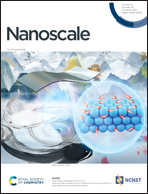Simple spectroscopic determination of the hard protein corona composition in AuNPs: albumin at 75%†
Abstract
We analyzed the different spectroscopic profiles of nanoparticle hard protein corona formation using two model proteins, albumin and immunoglobulin. When compared to serum, this served for the analysis of the hard protein corona main components. To do that, we employed time-resolved UV-Visible light absorption spectroscopy, dynamic light scattering, and zeta potential measurements during nanoparticle–protein incubation. Under the tested experimental conditions, the expected evolution from a non-stable (soft) to a stable (hard) protein corona was confirmed for serum and albumin. At the same time, immunoglobulin incubation inevitably failed to form a corona and led to nanoparticle aggregation. The formation profiles of the protein corona were similar in the case of albumin and serum, indicating the dominance of albumin coating the nanoparticle surface when exposed to plasma. This was confirmed by mass spectrometry. Chemical digestion of the nanoparticles bearing different protein coronas gave indications of the density of the different protein coatings. Overall, this study of the protein corona by determining the adsorption kinetics finger-print enables the development of precise nanotechnologies avoiding cumbersome processes and delaying proteomics analysis.



 Please wait while we load your content...
Please wait while we load your content...